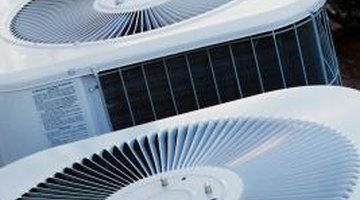Where to Drain Water With an HVAC Condensation Pump
The heating, ventilation and air conditioning -- or HVAC -- condensation pump disposes of wastewater produced in an air conditioner. The wastewater is condensation removed from the air as a byproduct of the machine's cooling process. This wastewater is produced when humid air comes in contact with the copper coils filled with refrigerant inside of the unit. The humidity condenses into water on the coils and drains into a pan before being removed by the pump. You should consider a number of things when considering where to drain water with an HVAC condensation pump.
Local Municipalities

Before placing a drain line for an HVAC condensation pump, you should check with your local code enforcement office to find out what is and is not allowed in your town. Many municipalities have laws against draining air conditioner condensation into the sanitary sewer system, and they might restrict where on your property you can drain your HVAC system. Knowing the rules ahead of time will spare you fines and the hassle of having to relocate your line.
Washing Machine Standpipe
Some HVAC condensation pumps drain into the washing machine drain standpipe -- the drain pipe behind your washing machine that's usually about 3 to 4 feet tall. These drain standpipes have the air gap necessary to accommodate a condensation drain line and may be conveniently located if your HVAC system is located near your laundry room.
Sump Pump
Sump pumps are used to keep basements and crawlspaces dry. They are typically installed in a pit in the floor and turn on when the water level inside the pit rises to a certain point. This makes them ideal for draining HVAC condensation, as they will not run continually but rather will kick on when the condensation level reaches that trigger point.
Outdoors
If the risk of freezing overnight temperatures is nonexistent while your air conditioner is running, you can run your HVAC condensation pump drain line outside your home. If you have a garden or hedges, the water is safe to use to irrigate these outdoor plants. Do not allow the drained water to accumulate near the foundation of your house, however, as prolonged dampness can cause rot and erosion problems.
References
Writer Bio
Andrew Leahey has been a writer since 1999, covering topics as varied as technology how-to guides and the politics of genetically modified organisms to African food supplies. He is pursuing his J.D. while renovating an 1887 farmhouse located in the New Jersey Pine Barrens.
Photo Credits
- Comstock/Comstock/Getty Images
More Articles



